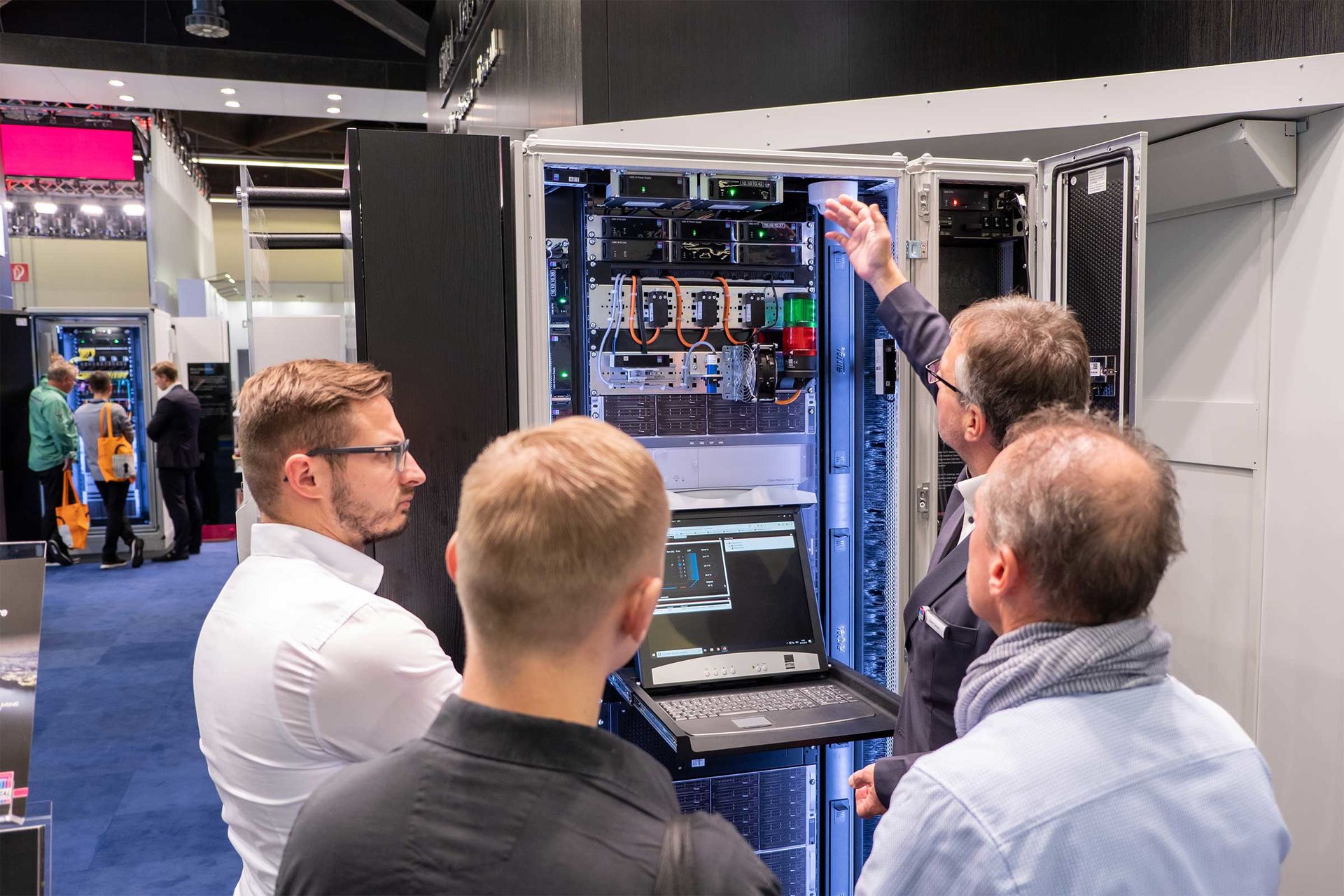European Heat Pump Summit Newsroom
Data centres

Chillventa, the No. 1 industry gathering for the international refrigeration, air conditioning, ventilation and heat pump community, cannot take place in its usual format this year. However, the organizers are working hard to present a virtual version of parts of the event, like the Chillventa CONGRESS, on the scheduled dates of 13 - 15 October 2020. One of the key aspects to be discussed will be the efficient air conditioning of data centres.
- COVID-19: current situation in data centres
“The coronavirus crisis is causing a rapid increase in data traffic. But Frankfurt’s data centres are confident they can cope. From a technical perspective, it has all been manageable so far,” writes Inga Janovic in the F.A.Z. newspaper on 19.3.2020. “A weekly review published by the operator of the world’s busiest internet hub in Frankfurt, DE-CIX, shows that some people are working differently while others are playing more online. Accordingly, the volume of data being exchanged between the many networks that make up the internet rose by 10% last week. The fact that many firms have switched to video conferencing has caused significantly more traffic in the web.”
“Without Frankfurt, none of this would work. Because this is the location of an extremely large number of data centres that also accommodate the infrastructure of telecommunications providers and major cloud operators like Amazon, Microsoft and Google as well as film streaming services like Netflix. In the same way as power companies and water utilities, it is very important that nothing goes wrong now with these data centres, as they are also categorised as critical infrastructure fundamental to the functioning of society,” the article goes on to say.
- How do we distinguish between different types of data centres?
As with supermarkets, you need to distinguish between the various operating models to understand demand, trends and market significance. There is no single type of supermarket or data centre. Corporate, on-premises, hosting, colocation, university, regional, research, hyperscale and edge data centres are just some of the terms that you will find in various publications. Another important term is Internet Exchange Point.
According to the Borderstep Institute’s basic classification, data centres are defined as all self-contained spatial units such as
server cabinets, server rooms, parts of buildings or entire buildings in which at least three physical servers are installed. The development of data centre capacities is calculated in particular on the basis of the server equipment in the data centres.
There are 50,000 data centres in Germany and in 2018 they used 14 billion kWh of electricity. That is 2.7% of total power consumption in Germany and almost 40% more than in 2010. According to estimates, the energy requirement in data centres worldwide was around 400 billion kWh in 2018 (source: TEMPRO Project and Borderstep Institute).
Corporate data centre
Data centre operated by a company or public agency for its own purposes, e.g. on its own premises (on-premises data centre).
Colocation data centre
Data centre whose operator rents out space to clients to install their own IT components and provides all main connections (power, network), air conditioning, a secure power supply, fire protection, access protection etc. The IT hardware is operated by the customers themselves. The Data Center Map shows that there are 210 such data centres in Germany. By way of comparison: 4,618 worldwide, 1,805 in the USA, 274 in the UK, 175 in Canada, 154 in France and 107 in the Netherlands.
Hosting data centre/cloud data centre
Data centre where the operator manages the IT as well as the data centre infrastructure. The operator rents out individual servers, computing and storage capacity, software as service, websites etc. to its customers. Cloud computing is driving the growth of these data centres.
Hyperscale data centres
Hyperscalers are systems used in the context of cloud computing. Several thousand or millions of servers are connected to one another to create an expandable network that allows massive scaling. It is estimated that there will be around 600 hyperscale data centres worldwide by 2021. Despite the dynamic growth in the data centre market in Germany, there is a risk that the country will lose out when compared internationally. In the booming segment for hyperscale data centres in particular, much more capacity is being established in other European countries, especially in the Netherlands, Ireland and Scandinavia. Operators of hyperscale data centres are avoiding Germany as a location above all because of the high cost of electricity and the at times protracted approval processes.
Edge computing is the distributed processing of data at the periphery (or edge) of the network. This means that in edge computing the data is processed directly at the network periphery, i.e. close to where the data is also being generated. Edge computing is an open, distributed IT architecture characterised by distributed processing power. Not only does edge computing create the basis for mobile computing, it also provides the technologies of the Internet of Things (IoT). In practice, edge computing means that data are processed directly by a (mobile) device, local PC or server, without transferring data to a data centre.
Emerging trend: Nowadays, turnkey data centres are becoming more widespread. This solution is a complete data centre offering a turnkey IT environment and suitable for use by all sizes of companies as an edge computing data centre. Equipped with cutting-edge cooling technology and innovative electrical supply systems, it offers everything necessary for successful operation, including the building shell.
Internet Exchange Points (IXPs)
Internet exchanges are the network nodes or network elements of the internet and serve as exchange points for the internet’s data traffic. Multiple internet service providers (often several hundred) can be connected to an internet hub in this way.
The German Commercial Internet Exchange (DE-CIX) is an internet exchange in Frankfurt and the largest in the world in terms of data traffic. All national and international activities and companies are brought together under the umbrella of DE-CIX Group AG.
- Energy-efficient cooling and effective utilisation of waste heat
Although in recent years there have been significant improvements in the energy efficiency of data centres, the rapidly increasing demand for centralised computing capacity has meant that the energy requirement in data centres in Germany has continued to rise. “Despite significant efficiency gains, the energy and resource demand of data centres in Germany is likely to increase by more than 50% by 2030,” explains Dr Ralph Hintemann from the Borderstep Institute. “Industry and society are producing increasingly more data that needs to be transferred, processed and stored. And this leads to even more very large data centres.”
With new technologies like autonomous driving, Industry 4.0 and the expansion of the 5G mobile network, more and more smaller edge computing data centres are also being established.
Despite all the potential future efficiency improvements in IT components and infrastructure, almost 100% of the electricity used in data centres in Germany is converted to heat and then released to the environment, generally using additional energy for ventilation and cooling in the process. However, the example of Sweden shows that it is perfectly possible to utilise the waste heat from data centres under the right conditions.
In view of their increasing power requirements, the issue of waste heat recovery in data centres is becoming especially important. In 2018, more than 14 billion kWh of electricity in Germany’s data centres was converted to heat that was then discharged to the atmosphere unused. There are many applications that need heat all year round, for example for use in swimming pools, laundries or greenhouses. The heat requirement for hot water alone was more than 120 billion kWh in Germany in 2015.
More than 50% of the data centre operators surveyed by NeRZ (Energy-efficient Data Centre Network) envisage great potential in future through waste heat recovery. More than 30% of the respondents are already utilising waste heat. At present, the high electricity prices and low gas prices in Germany are still a challenge for the economic efficiency of heat pumps for utilising waste heat from data centres.
At the virtual Chillventa CONGRESS there will be an event specifically dedicated to this topic. The effective use of waste heat from cooling systems will be discussed with reference to examples. Participants will have the opportunity to get information directly from the experts involved. The TEMPRO Project – Total Energy Management for Professional Data Centers, will also present its results.
Sources (in German)
Borderstep Institute (Link1, Link2, Link3, Link4)
Total Energy Management for Professional Data Centers TEMPRO (Link)
Rechenzentrum-Datacenter de (Link)
Data Center Map (Link)
Deutschlands große Data Center (Link)
Cloud Servers in Deutschland (Link)
Rechenzentren Liste Colocation (Link)
Internet Exchange Points (IXPs) in Deutschland (Link)
De-CIX (Link)
Das schlüsselfertige Rechenzentrum (Link)
Abwärmenutzung im Rechenzentrum (Link)
Beispiele für Abwärmenutzung: (Link1, Link2, Link3)
NeRZ-Kurzstudie (Link)
Author and compiler of texts: Dr Rainer Jakobs
